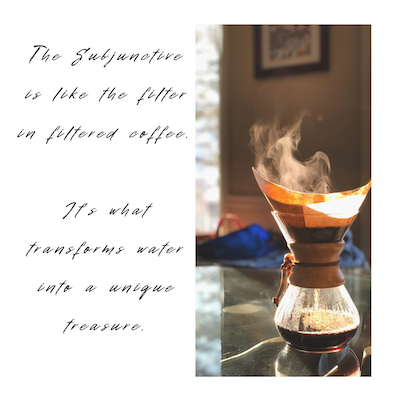Whenever I ask my new students, subscribers, or any member of my audience, what they struggle with, the answer is always: the Subjunctive.
And I get it. There are things in English whose logic took me time to get. And there are things I still don’t get like, the pronunciation for example.
Unfortunately, no mnemonic rule will help you understand the Subjunctive, because the Subjunctive is not a WEIRDO. Poor “emo” subjunctive! Spanish Subjunctive is unreal, though.
But the problem is that, if you approach the Subjunctive trying to “hack” it or finding a “magic” rule, like the WEIRDO one, you will end up finding more exceptions than normality. As a result, you might end up developing fear and hatred towards the Subjunctive, placing the Subjunctive in the “illogical” box and trying to avoid using it. And, therefore, making yourself a forever “non-fluent” or “non-natural” Spanish speaker, and making your expression in Spanish much poorer.
The Spanish Subjunctive is not weird and you can’t do Spanish with out it. The good news is that is very logical and follows a “rule” as in, it follows a “principle of behavior”. It always behaves in the same way!
As George Julian wrote for Fluent in 3 months: “If they [Spanish speakers] need to choose between habla (indicative) and hable (subjunctive), they don’t think about what the “rules” are. They simply pick the word that means what they want to say. The “WEIRDO” mnemonic doesn’t factor into their reasoning. So, if you want to use the subjunctive correctly, this is the first and most important step you must take: you must understand what it means.”
And I couldn’t agree more.
This post is about the one thing you need to understand what the Subjunctive means, so you can use it well once and for all.
The Subjunctive is unreal, as in, it is amazing but also as in, it is non-factual, not-real.
Extract of Spanish Subjunctive Masterclass
Why do you need subjunctive? Because we are humans, not machines telling data. Sometimes we need to be as neutral and objective as we can, but most of the time we tell things subjectively, from our point of view.
Almost without realizing it, we are assessing information and we communicate our personal take on the information we relate. Es importante que mi pareja me escuche. It’s important that my partner listens to me. As obvious as it sounds, this is not a fact.
The piece of information “my partner listens to me” is not fact, it is something that I consider important. I assess that information as something important “to me”. There is an emotion attached to this information, so if my partner doesn’t listen to me I’d be pissed.
You might be surprised at the type of information we commonly communicate in our conversations. We tend to express ourselves, our point of view, our emotions, or will, more often than we relate facts.
So, going back to the questions I posed you at the beginning. Why do you need Subjunctive? Because we need subjunctive to talk about everything that is not a fact.
This is just the introduction of the course, but in these words lay the entire mindset of the Subjunctive.
The rest of the pages only go through every case and situation to show how they follow the rule, always and with no exception, so you can find confidence in their use.
So, the Indicative tells truths, data, passes on raw and unfiltered information, facts. Indicative is REAL.
The Subjunctive acts as a mirror of the indicative but coating all those facts and truths and data with the filter of emotion, transforming them then in non-factual. The Subjunctive is the filter that transforms plain and neutral facts into a subjective thing. And that thing is NOT A FACT anymore, it is something else: it is my personal assessment, my desire, it’s something I don’t know it’s real…

Subjunctive: Transforming Facts into Non-Facts
Yo estoy enfadada porque mi jefe es un machista. — Both are facts. Cause and effect: Yo estoy enfadada is very much a fact. It also is a fact (or I am conveying it as a fact) that mi jefe es machista.
However,
Me enfada que mi jefe sea machista. — The only fact here is that something angers me, the other information is tainted by my anger. The information here is not that my boss is sexist, but that it angers me that he is.
Es importante que haga meditación todos los días. —- Also, not a fact because what is important for me might not be for others. The only fact here is that I consider something to be important (indicativo). The thing I consider important is not a fact (subjuntivo).
So, it is ESSENTIAL that you question what is it you want to communicate when you speak Spanish. Do you want to convey something as a fact or truth? Or you want to express how that fact makes you feel, that you want it, or that you don’t know it to be true?
Let me show you the difference between facts and not-facts. Read the following sentences:
FACTS
Juan ha venido.
Sé que Juan ha venido.
Creo* que Juan ha venido.
Those were facts. But, when one doesn’t know if the information is real, we have a NON-FACT.
Ignoro que Juan haya venido.
No creo que* Juan haya venido.
What does it look like when I say that the Subjunctive is a coat of EMOTION over the fact? Have a look at the following sentences:
Quiero que Juan venga (It’s my desire, and desire comes from the heart, Desire is the emotion of longing or hoping for a person, object, or outcome)
Me gusta que Juan venga. (How I feel about it)
Es fantástico que Juan venga. (How I feel about it)
Ójala que Juan venga. (Desire, what I want)
Pepa le está diciendo a Juan que venga. (Instruction, what I want)
Invito a Juan para que venga. (My purpose, what I want)
Hablaré con Juan cuando venga. (Future, not real yet)
No hablaré con Juan aunque venga (Objection, not real yet)
Just, look at the dichotomy “creo + indicativo” and “no creo + subjuntivo”. This is not illogical and a “quirk” that one has to memorise.
( * ) For a native Spanish speaker, a belief is as real as a fact, therefore we use Indicative to talk about our beliefs. However, if I negate my belief, that makes it not real. If I negate reality, it means that it’s not real. Therefore, I use Subjunctive.
Subjunctive: Looking at Reality through the Looking-Glass
Think of the Subjunctive as “reality seen through the looking-glass,” where we see an imaginary o non-real world on the other side of the mirror that reflects the reality but it not real.
As Lewis Carrol said:
“I’m not strange, weird, off, nor crazy, my reality is just different from yours”
He probably wasn’t referring about the Spanish Subjunctive, but if the Spanish Subjunctive were a person, it would be most definitely saying those words.
And is it not wonderful that we can consciously express this non-reality with a choice of a verb? Is it not a great enhancement of communication that we can filter our imaginary (non-real) world on the other side of the mirror by using one mood or another, either Indicative or Subjunctive?
If this blogpost has clarified your understanding of the Spanish Subjunctive and you want to go deep into this topic and finally dig strong roots about the Subjunctive so you can use it easily and correctly, I invite you to get the Spanish Subjunctive Masterclass.
This masterclass is a self-paced mini-course formed of 3 videos, a booklet, 3 workbooks and a 90min Q&A session to solve any question you might have. But if your questions are still not solved after this course, you can always email me and we answer directly all your questions!
The price of this course is 30€ / $32 US.


